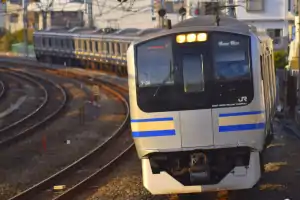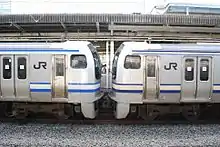E217 series
The E217 series (E217系) is a suburban electric multiple unit (EMU) train type operated by East Japan Railway Company (JR East) in the Kantō region of Japan since 1994.[1]
| E217 series | |
|---|---|
 E217 series set Y-36 at the Ofuna overpass | |
| In service | 1994–Present |
| Manufacturer | Tokyu Car, Kawasaki Heavy Industries, JR East (Niitsu/Ofuna) |
| Replaced | 113 series |
| Constructed | 1994–1999 |
| Entered service | 3 December 1994 |
| Refurbished | 2008–2012 |
| Number built | 745 vehicles (97 sets) |
| Number in service | 726 vehicles (94 sets) |
| Successor | E235-1000 series |
| Formation | 11+4 cars per trainset |
| Fleet numbers | Y-01 – Y-51, Y-101 – Y-146 |
| Operator(s) | JR East |
| Depot(s) | Kamakura |
| Line(s) served | Yokosuka Line, Sōbu Main Line |
| Specifications | |
| Car body construction | Stainless steel |
| Car length | 19,500 mm (64 ft 0 in) (20,000mm or 65ft 7in when couplers included) |
| Width | 2,950 mm (9 ft 8 in) |
| Doors | 4 per side |
| Maximum speed | 120 km/h (75 mph) |
| Traction system | Variable frequency (GTO/IGBT) |
| Power output | 1,520 kW |
| Acceleration | 2.0 km/h/s |
| Deceleration | 4.2 km/h/s |
| Electric system(s) | 1,500 V DC overhead catenary |
| Braking system(s) | Regenerative brake |
| Safety system(s) | ATS-P, ATS-SN, ATC (not service) |
| Coupling system | Shibata type |
| Track gauge | 1,067 mm (3 ft 6 in) |
Design
Introduced in 1994 to replace the 113 series EMUs running on the Sōbu Line (Rapid) and Yokosuka Line, it was the first outer-suburban train type in Japan to feature four pairs of doors per side on car. The basic design was developed from the 209 series commuter EMUs. It replaced all the Yokosuka Line 113 series trains by 1999. The trains were built jointly by Kawasaki Heavy Industries, Tokyu Car, and JR East (Niitsu and Ofuna factories).[2]
They use Mitsubishi IGBT transistors (formerly GTO) and VVVF inverters with Mitsubishi MT68/73 traction motors. The gear ratio is 97:16.
Operations
- Kashima Line (Sawara - Kashima-Jingū)
- Narita Line (Chiba - Narita Airport, Sawara)
- Sōbu Main Line (Tokyo - Narutō)
- Sotobō Line (Chiba - Kazusa-Ichinomiya)
- Uchibō Line (Chiba - Kimitsu)
- Yokosuka Line
Former operations
- Shōnan–Shinjuku Line (Shinjuku - Zushi) (December 2001 - October 2004)
- Tōkaidō Main Line (Tokyo - Atami) (March 2006 - March 2015)
- Airport Narita (name discontinued March 2018)
Formations
11-car Yokosuka/Sōbu Line sets
As of 5 January 2021, 50 11-car sets (Y-01–Y-51) are based at Kamakura Depot and formed with four motored ("M") cars and seven non-powered trailer ("T") cars.[4]
← Kimitsu, Narita Airport Kurihama → | |||||||||||
| Car No. | 11 | 10 | 9 | 8 | 7 | 6 | 5 | 4 | 3 | 2 | 1 |
|---|---|---|---|---|---|---|---|---|---|---|---|
| Designation | Tc | T | M | M' | T | T | Tsd | Tsd' | M | M' | Tc' |
| Numbering | KuHa E217 | SaHa E217 | MoHa E217 | MoHa E216-1000 | SaHa E217-2000 | SaHa E217-2000 | SaRo E217 | SaRo E216 | MoHa E217-2000 | MoHa E216-2000 | KuHa E216-2000 |
- Cars 3 and 9 each have one scissors pantograph.
- Cars 1 and 11 have an accessible/priority "free space".
- Cars 1, 5, and 11 each have a toilet (universal design in car 1, Japanese-style in car 11).
- Car 8 is designated as a mildly air-conditioned car.
- Cars 4 and 5 are bilevel Green Cars with transverse seating.
- Cars 9, 10, and 11 have a mix of longitudinal and transverse box seating.
| Formation List | |||||||||
|---|---|---|---|---|---|---|---|---|---|
| ❌ represents that the set is removed from service | |||||||||
| Y-1 | Y-2 | Y-3 | Y-4 | Y-5 | Y-6 | Y-7 | Y-8 | Y-9 | Y-10 |
| Y-11 | Y-12 | Y-13 | Y-14 | Y-15 | Y-16 | Y-17 | Y-18 | Y-19 | Y-20 |
| Y-21 | Y-22 | Y-23 | Y-24 | Y-25 | Y-26 | Y-27 | Y-28 | Y-29 | Y-30 |
| Y-31 | Y-32 | Y-33 | Y-34 | Y-35 | Y-36 | Y-37 | Y-38 | Y-39 | Y-40 |
| Y-41 | Y-42 | Y-43 | Y-44 ❌[5] | Y-45 | Y-46 | Y-47 | Y-48 ❌ | Y-49 | Y-50 |
| Y-51 | |||||||||
4-car Yokosuka/Sōbu Line sets
As of 1 July 2020, 46 four-car sets (Y-101–Y-146) are based at Kamakura Depot and formed with two motored ("M") cars and two non-powered trailer ("T") cars.[4]
← Kimitsu, Narita Airport Kurihama → | ||||
| Car No. | +4 | +3 | +2 | +1 |
|---|---|---|---|---|
| Designation | Tc | M | M' | Tc' |
| Numbering | KuHa E217-2000 | MoHa E217-2000 | MoHa E216-2000 | KuHa E216-1000/2000 |
- Car +3 has a scissors pantograph.
- Cars +1 and +4 have an accessible/priority "free space".
- Car +1 has a Japanese-style toilet.
| Formation List | |||||||||
|---|---|---|---|---|---|---|---|---|---|
| ❌ represents that the set is removed from service | |||||||||
| Y-101 | Y-102 | Y-103 | Y-104 | Y-105 ❌[6] | Y-106 | Y-107 ❌[6] | Y-108 | Y-109 | Y-110 |
| Y-111 | Y-112 | Y-113 | Y-114 | Y-115 | Y-116 | Y-117 | Y-118 | Y-119 | Y-120 |
| Y-121 | Y-122 | Y-123 | Y-124 | Y-125 | Y-126 | Y-127 | Y-128 | Y-129 | Y-130 |
| Y-131 | Y-132 | Y-133 | Y-134 | Y-135 | Y-136 | Y-137 | Y-138 | Y-139 | Y-140 |
| Y-141 | Y-142 | Y-143 | Y-144 | Y-145 | Y-146 | ||||
10-car Tōkaidō Line sets
Three 10-car sets (F-01–F-03) were based at Kōzu Depot and formed with four motored ("M") cars and six non-powered trailer ("T") cars.[7]
← Tokyo Atami → | ||||||||||
| Car No. | 10 | 9 | 8 | 7 | 6 | 5 | 4 | 3 | 2 | 1 |
|---|---|---|---|---|---|---|---|---|---|---|
| Designation | Tc | M | M' | T | T | Tsd | Tsd' | M | M' | Tc' |
| Numbering | KuHa E217 | MoHa E217 | MoHa E216-1000 | SaHa E217-2000 | SaHa E217-2000 | SaRo E217 | SaRo E216 | MoHa E217-2000 | MoHa E216-2000 | KuHa E216-2000 |
- Cars 3 and 9 each had one scissors pantograph.
- Cars 1 and 10 had an accessible/priority "free space".
- Cars 1, 5, and 10 each had a toilet (universal design in car 1, Japanese-style in car 10).
- Car 8 was designated as a mildly air-conditioned car.
- Cars 4 and 5 were bilevel Green Cars with transverse seating.
- Cars 9 and 10 had a mix of longitudinal and transverse box seating.
5-car Tōkaidō Line sets
Three five-car sets (F-51–F-53) were based at Kōzu Depot and formed with two motored ("M") cars and three non-powered trailer ("T") cars.[7]
← Tokyo Atami → | |||||
| Car No. | 15 | 14 | 13 | 12 | 11 |
|---|---|---|---|---|---|
| Designation | Tc | T | M | M' | Tc' |
| Numbering | KuHa E217-2000 | SaHa E217 | MoHa E217-2000 | MoHa E216-2000 | KuHa E216-1000 |
- Car 13 had a scissors pantograph.
- Cars 11 and 15 had an accessible/priority "free space".
- Car 11 had a Japanese-style toilet.
- Car 14 had a mix of longitudinal and transverse box seating.
 E217 series in Shōnan livery, April 2007
E217 series in Shōnan livery, April 2007
Interior
.jpg.webp) E217 series longitudinal seating
E217 series longitudinal seating E217 series transverse seating
E217 series transverse seating Green car upper saloon with Suica card touch panels, August 2010
Green car upper saloon with Suica card touch panels, August 2010 Green car lower saloon with Suica card touch panels, August 2010
Green car lower saloon with Suica card touch panels, August 2010
History

The E217 series trains entered revenue service from 3 December 1994.[7]
From December 2001, 11-car trains were used on the Shōnan–Shinjuku Line between Shinjuku and Zushi. This continued until October 2004 when Shōnan–Shinjuku Line services were unified using E231-1000 series trains.
In March 2006, three 15-car trains were reformed as 10+5-car sets and transferred to Kōzu depot for use from 14 March 2006 on Tōkaidō Main Line duties out of Tokyo alongside E231-1000 series trains. The sets were repainted into the same Shonan color scheme of orange and green bodyside stripes as applied to the E231s. These sets were all transferred back to Yokosuka/Sōbu Line services by March 2015.
A program of refurbishment on the fleet commenced in 2008 and was completed in 2012. Externally, sets received lighter blue and cream stripes.
The sets are being replaced by the newer E235-1000 series and transferred to Nagano depot for scrapping since the fiscal year 2020. The first withdrawn set was transferred to Nagano between January 5 and 6, 2021.[5]
Incidents
On December 25, 2014, an 11+4 car train consisting of sets Y12 and Y129 broke down on the Yokosuka Line due to electrical problems; another 11+4 car train consisting of sets Y23 and Y130 was sent to tow the faulty set from Tokyo Station to Kamakura Depot, creating an immensely long thirty-car train. While this was happening, the entire train did not stop at any stations to pick up any passengers.
References
- JR全車輌ハンドブック2009 [JR Rolling Stock Handbook 2009]. Japan: Neko Publishing. 2009. pp. 269–270. ISBN 978-4-7770-0836-0.
- Saka, Masahiro (March 2014). "JR第1世代の車両・現況と概要" [JR 1st-generation rolling stock: Current situation and overview]. Tetsudō Daiya Jōhō Magazine (in Japanese). Vol. 43 no. 359. Japan: Kōtsū Shimbun. p. 23.
- "E217系鎌倉車両センター本所編成表(最新版)" [E217 series Kamakura Depot formation list (latest)]. Retrieved 1 July 2020.
- "クラY-44編成長野へ" (in Japanese). Japan. 6 January 2021. Retrieved 21 January 2021.
- "クラY-105・Y-107編成長野へ" (in Japanese). Japan. 6 January 2021. Retrieved 21 January 2021.
- JR電車編成表 2011夏 [JR EMU Formations - Summer 2011]. Japan: JRR. May 2010. ISBN 978-4-330-21211-1.
Further reading
- 首都圏新系列車両PROFILE [Tokyo Area New-generation Rolling Stock Profile]. Japan: Ikaros Publishing. 15 April 2011. ISBN 978-4-86320-436-2.